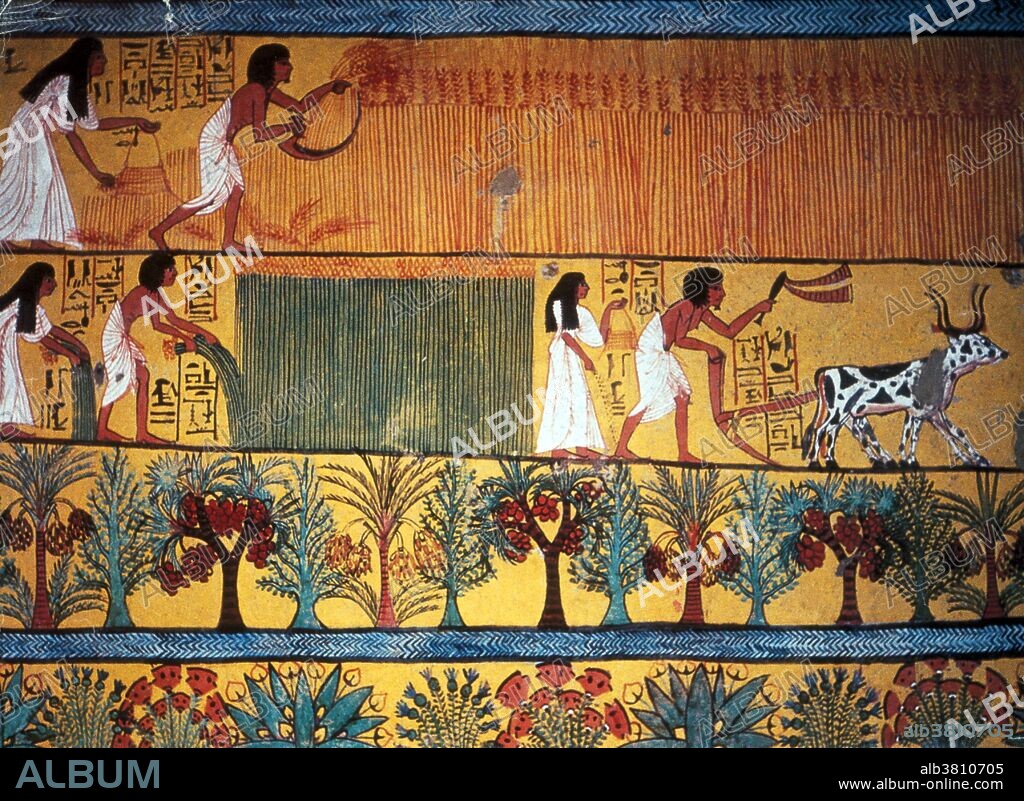alb3810705
Ancient Egyptian Agriculture, 1200 BC

|
Añadir a otro lightbox |
|
Añadir a otro lightbox |



¿Ya tienes cuenta? Iniciar sesión
¿No tienes cuenta? Regístrate
Compra esta imagen.
Selecciona el uso:

Título:
Ancient Egyptian Agriculture, 1200 BC
Descripción:
Traducción automática: Pintura de la cámara funeraria de Sennedjem, 1200 a. C. La civilización del Antiguo Egipto estaba en deuda con el río Nilo y sus inundaciones estacionales constantes. La previsibilidad del río y la fertilidad del suelo permitieron a los egipcios construir un imperio sobre la base de una gran riqueza agrícola. Se considera que los egipcios fueron uno de los primeros grupos de personas en practicar la agricultura a gran escala. Esto fue posible gracias al ingenio de los egipcios cuando desarrollaron el riego por cuenca. Sus prácticas agrícolas les permitieron cultivar alimentos básicos, especialmente cereales como el trigo y la cebada, y cultivos industriales, como el lino y el papiro. El antiguo artesano egipcio Sennedjem vivió en Set Maat (traducido como El Lugar de la Verdad), la actual Deir el-Medina, en la orilla oeste del Nilo, frente a Tebas, durante los reinados de Seti I y Ramsés II. Sennedjem tenía el título de "Siervo en el Lugar de la Verdad". Fue enterrado junto con su esposa, Lyneferti, y su familia en una tumba en la necrópolis del pueblo. Su tumba fue descubierta en 1886.
Painting from the burial chamber of Sennedjem, 1200 BC. The civilization of Ancient Egypt was indebted to the Nile River and its dependable seasonal flooding. The river's predictability and the fertile soil allowed the Egyptians to build an empire on the basis of great agricultural wealth. Egyptians are credited as being one of the first groups of people to practice agriculture on a large scale. This was possible because of the ingenuity of the Egyptians as they developed basin irrigation. Their farming practices allowed them to grow staple food crops, especially grains such as wheat and barley, and industrial crops, such as flax and papyrus. The Ancient Egyptian artisan Sennedjem lived in Set Maat (translated as The Place of Truth), contemporary Deir el-Medina, on the west bank of the Nile, opposite Thebes, during the reigns of Seti I and Ramesses II. Sennedjem had the title, "Servant in the Place of Truth". He was buried along with his wife, Lyneferti, and family in a tomb in the village necropolis. His tomb was discovered in 1886.
Crédito:
Album / NYPL/Science Source
Autorizaciones:
Tamaño imagen:
4350 x 3179 px | 39.6 MB
Tamaño impresión:
36.8 x 26.9 cm | 14.5 x 10.6 in (300 dpi)
Palabras clave:
2ND CENTURY B. C. • AGRICOLA • AGRICULTURA • ANTIGUO EGIPTO • ANTIGUO • ANTIGÜEDAD • ARQUEOLOGIA • ARQUEOLÓGICA • ARQUEOLOGICO • ARQUEOLÓGICOS • ARTE • BUEY • BUEYES • CAMARA FUNERARIA • CAMARA MORTUORIA • CAMARA SEPULCRAL • CEBADA • CIENCIA • CIVILIZACION ANTIGUA • COMIDA • CULTURA ANTIGUA • DEIR EL-MEDINA • FAMOSA • FAMOSO • FAMOSOS • FRESCO • HISTORIA • HISTORICO • HOMBRES • IMPORTANTE • MONUMENTO • MUJERES • MURAL • OBRA DE ARTE • OX • PINTURA AL FRESCO • PINTURA EN PARED • PINTURA MURAL • PINTURA • PLANTAR • RUINAS • S. II AC • SENNEDJEM, • SIGLO II A. C. • SIGLO II AC • SÍTIO • TEMPLO • TRIGO • TUMBA
 Pinterest
Pinterest Twitter
Twitter Facebook
Facebook Copiar enlace
Copiar enlace Email
Email
